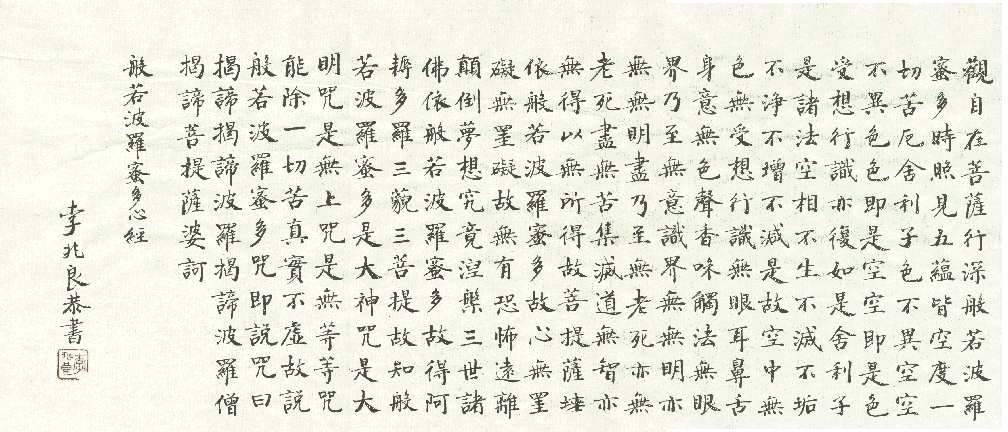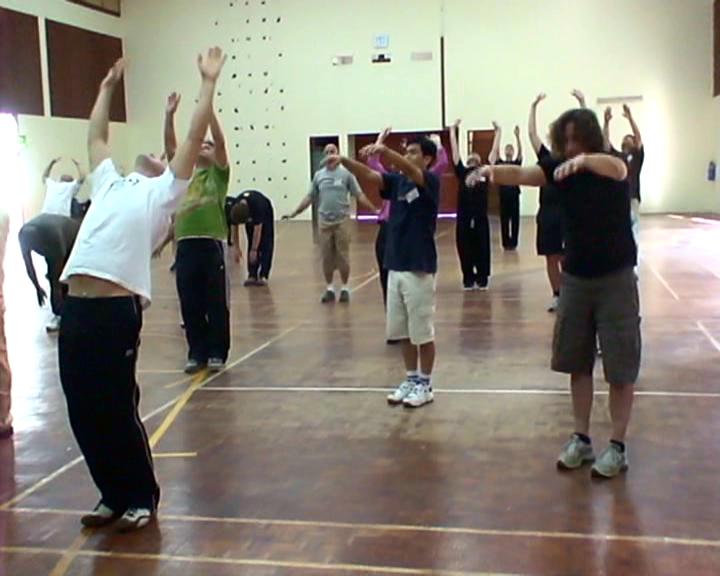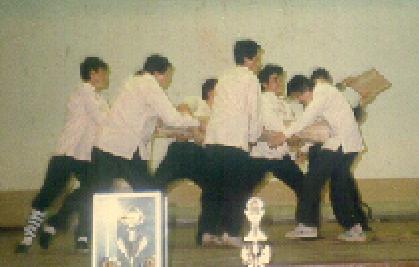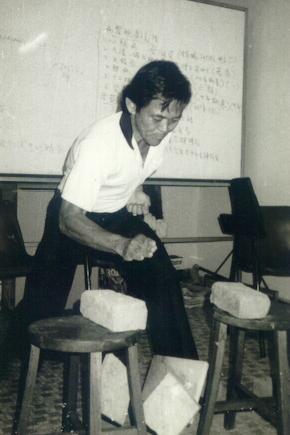SELECTION OF QUESTIONS AND ANSWERS
MARCH 2013 PART 2

The complete Heart Sutra in Chinese, reproduced from http://1.bp.blogspot.com/-O-GL6O1F37o/T3O_bTf9tyI/AAAAAAAABpg/1lxs6z6_nlo/s1600/2%2BHeart%2BSutra.gif
Question 1
Can you please give us some background about sutras?
— Sifu Roland Mastel, Switzerland
Answer
Sutras are the verbatim teaching of the Buddha. When the Buddha attained paranirvana, i.e. left this phenomenal world and returned to Cosmic Reality, his disciples were concerned that the Buddha's teaching might eventually be lost.
Five hundred of the Buddha's disciples, known as the 500 Arahans, met in a conference to review and confirm the Buddha's teaching.
Ananda, who was the Buddha's personal attendant and therefore had heard all of the Buddha's teaching, and who also had the miraculous power of remembering everything he had heard, recited the Buddha's teaching word by word. The verbatim report was verified and confirmed by all the Arahans present.
The Buddha's teaching was recited or chanted by monks. With only a few exceptions, sutras always start with the phrase "Thus have I heard" , which reminds that they were reported by Ananda verbatim. It was a few hundred years later that the sutras were written down.
Question 2
Can you please tell us something about the Heart Sutra as I have often heard it mentioned?
Answer
The Heart Sutra is very important in Buddhism, especially in Zen Buddhism. It is a record of the enlightenment experience of Bodhisattva Avalokitesvara or Guan Yin Bodh Satt. In Chinese it consists of only about 162 words, yet it contains the gist of Buddhist philosophy.
In deep meditation Guan Yin Bodh Satt perceives that form is the same as emptiness, and emptiness is the same as form. All phenomena are empty. There is no birth and no death, no defilement and no purity, no adding and no subtracting.
There is no reality perceived by eyes, ears, nose, tongue, body and mind. There is no sight, sound, smell, taste, feeling and substance. There is no ignorance, and end of ignorance, no age and death and no end of age and death.
There are no four noble truths and no eight-fold path. Because there is nothing, there is no blockage. Hence, bodhisattvas employing the practice of perfection attain the supreme Enlightenment.

Not many people realize that skills are more important than techniques in learning chi kung. Here students at an Intensive Chi Kung Course in Sabah perform chi kung skilfully to generate an energy flow
Question 3
As a Shaolin grandmaster, your knowledge would be most valuable for those seeking the real art.
— Yasmine, New Zealand
Answer
More valuable than knowledge which can be obtained from books or the internet, seekers of the art should personally learn skills from genuine masters and grandmasters.
Not many people may know the difference between techniques and skills. Many people mistakenly think that if they know the techniques of an art and practice the techniques diligently, they will get the benefits that art is meant to give. This is glaringly not so, though most people do not realize it.
The chi kung and kungfu techniques practiced by thousands of practitioners today are correct, yet very few derive the benefits of chi kung and kungfu despite many years of practice. The basic benefit of chi kung training is to have good health, yet many chi kung practitioners are weak and sickly! The basic benefit of kungfu training is self-defence, yet most kungfu practitioners do not know how to defend themselves!
Why? Let me tell you the secret. They have the right techniques but do not have the appropriate skills.
An analogy will make this clearer. You can learn the correct techniques of swimming or driving a car, but if you do not have the appropriate skills you still cannot swim or drive. In the same way, practitioners can learn the correct techniques of chi kung and kungfu, but if they do not have the appropriate skills, they still are not healthy and cannot defend themselves.
Genuine masters are rare nowadays, genuine grandmasters are rarer. If they are willing to teach the appropriate chi kung and kungfu skills, seekers of the arts should not miss the opportunity to learn from them.
Question 4
May we have the privilege of getting as much information as possible on the Golden Bell art, the training methods, stages, techniques, and so on from you. Of course one cannot learn this art merely from written description. But it would be a treasure for posterity to have a sort of documentary of the Golden Bell art you inherited from your teachers.
Answer
A main reason why genuine masters do not reveal the training methods of these advanced arts is because they do not want unsuspecting students to harm themselves by practicing these methods read from books. This is a real, serious reason, though many readers may not believe it.
Moreover, even if the masters were to reveal the methods, without the personal guidance of a competent teacher, students would be unable to carry out the exercise.
A brief description of Golden Bell will illustrate what I mean. I would strongly want readers not to attempt the exercise described below. Without the guidance of a competent teacher, they are likely to harm themselves.
Practice stance training, like Golden Bridge or Lifting Water, for a reasonable period of time. Then practice Abdominal Breathing, or better still, the Small Universe.
Systematically hit yourself with bags of beans, first gently, then hard. The bags should be of double layers to prevent bean dust filtering into your body.
Then hit yourself with bundles of canes. The canes should be treated with medicated wine to prevent contamination. Ram the ends of the canes into your vital points, first gently, then hard.
Then hit yourself with bags of pebbles, first gently, then hard. The bags should be of two layers to prevent dust of the pebbles filtering into your body. Wash the pebbles in running water once a week. Leave the pebbles in a cool place to dry on their own. Do not place them under the sun.
Periodically take medical concoction or perform chi kung exercise to clear any injuries sustained unwittingly.
The hitting with bags of beans, canes and pebbles is actually Iron Shirt training to confirm and consolidate a buffer of chi protecting the body. The training that creates the buffer of chi is the initial chi kung exercise. Hence, many masters, including many instructors in our school, have Golden Bell even without the hitting with beans, canes and pebbles.
There was a story of grandmaster Lam Sei Weng fighting with a Northern Shaolin master who gave grandmaster Lam a double flying kick. Despite the kick landing on him, grandmaster Lam remained unhurt like a solid rock, then with a technique known as Wave-Breaking Hands sent the opponent flying back with his legs broken. Grandmaster Lam had developed Golden Bell, most likely from his Iron Wire Set training, without having to hit himself with beans, canes and pebbles.

An old photograph showing Sifu Goh Kok Hin, a senior disciple of Grandmaster Wong, demonstrating Golden Bell, being rammed by a tree trunk
Question 5
There is a lot of mis-information on the internet -- I for one am not so naive as to believe it. There are manuals on Shaolin 72 Arts being sold, where the training of Golden Bell is just "beat yourself up to a pulp" and let your body adjust. Surely that can't be it!
Answer
Yes, there is a lot of mis-information on the internet, some of which is very harmful, though there is also a lot of useful information. One must differentiate the good from the bad.
Golden Bell training is certainly not beating yourself up to a pulp. Similarly combat training is not a generous exchange of blows.
Actually the descriptions found in the manuals of the Seventy Two Shaolin Arts are generally correct. The descriptions are concise and uninitiated readers normally are unable to carry out the instructions due to their lack of appropriate skills. They are likely to harm themselves if they attempt to follow the instructions.
Question 6
Also, I read a lot about Cosmos Palm in your books. But I can't find a definition of what you mean by Cosmos Palm. It appears that it's similar or the same as Iron Palm. Am I correct to interpret that you can attain Cosmos Palm from practicing sufficiently the Pushing Mountains exercise?
Answer
Cosmos Palm is very different from Iron Palm.
Iron Palm is hard, whereas Cosmos Palm is soft. Iron Palm may not penetrate Iron Shirt or Golden Bell, but Cosmos Palm can. Iron Palm does not contribute to good health, vitality and longevity, but Cosmos Palm does.
Iron Palm is excellent for breaking bricks and bones but does not enable the practitioner to have better results no matter what he does, whereas besides enabling the practitioner to break bricks and bones, Cosmos Palm also enables him to have better results in whatever he does.
Examples of applying Cosmos Palm to break bricks can be seen in Brick Breaking Galore. It was an impromptu demonstration after a Chi Kung Healing Course session. None of the masters did any hard-conditioning like hitting sand-bags before.
Though Pushing Mountains is a main exercises, by itself it is insufficient to produce Cosmos Palm.

An old photograph showing Sifu Cheng Shang Shou, a senior disciple of Grandmaster Wong, demonstrating Cosmos Palm, breaking a marble slab with a seemingly gentle tap
Question 7
Also, can you explain what is the main difference between Big Windmill and Forceful Big Windmill apart from the "sher" sounds etc? What would be the purpose of Forceful Windmill if one already practices the normal Big Windmill exercise?
Answer
Big Windmill is performed gently, whereas Forceful Big Windmill is performed with internal force. In Big Windmill, energy is flowing, whereas in Forceful Big Windmill, energy is consolidated.
Although they look similar, the normal Big Windmill and the Forceful Big Windmill are quite different.
The Forceful Big Windmill is one of the exercises to develop Cosmos Palm. While the normal Big Windmill is effective for overcoming pain and illness, and attaining good health, vitality and longevity, it is not sufficient to develop the type of internal force required by Cosmos Palm.
Question 8
Are all the breathing inhale through nose and exhale through mouth? Do you have to put the tongue to upper palate, and contract anus? I read about these pointers in chi kung books but don't find them required in your chi kung descriptions. Are they necessary?
Answer
Inhaling through the nose and exhaling through the mouth is the most common mode of breathing we use in our chi kung exercises. There are also other modes, like breathing out through the teeth, and exploding forcefully but in a relaxed manner.
Placing the tongue at the upper palate and contracting the anus is required in some parts of the Small Universe training. It is not necessary in most other chi kung exercises.
LINKS
Selected Reading
- Zen, Buddhism and Spiritual Cultivation
- Men Kiew or Asking Bridge
- Secrets in Free Sparring Methodology
- The Tai Chi Chuan Festival is a Dream Come True
- Baguazhang Review
